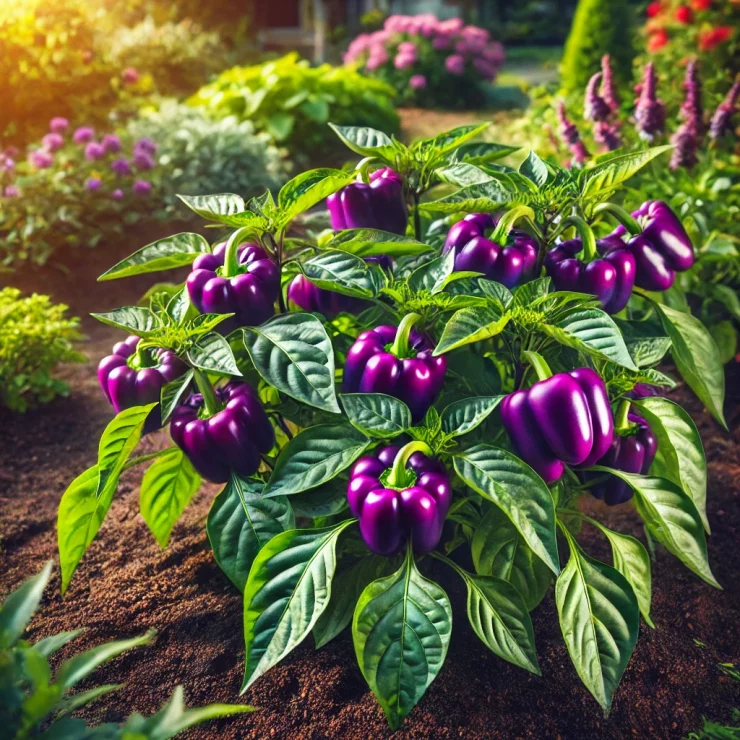Purple peppers are a striking addition to any garden, offering vibrant color and a unique twist on the classic bell pepper. Not only are they visually appealing, but they also pack a punch of flavor and nutrients. Growing purple peppers can be a rewarding experience, but like all plants, they require proper care and attention. Here are seven steps to successfully grow purple peppers in your garden.
1.Choose the Right Variety
Before you start planting, it’s important to choose the right variety of purple peppers. There are several types available, including Purple Beauty, Lilac Bell, and Tequila Sunrise. Each variety has its own unique flavor, size, and growing requirements, so pick one that suits your taste and garden conditions.
Tips for Choosing:
Purple Beauty: A popular variety known for its sweet flavor and medium size. Great for salads and grilling.
Lilac Bell: A smaller pepper with a milder taste, perfect for fresh eating and pickling.
Tequila Sunrise: A slightly spicy variety with a tapered shape, ideal for adding color to salsas and stir-fries.
2.Start Seeds Indoors
Purple peppers, like other pepper varieties, require a long growing season. To get a head start, it’s best to start seeds indoors 8-10 weeks before the last expected frost. This will give the seedlings enough time to develop before being transplanted into the garden.
How to Start Seeds:
Fill seed trays with a high-quality seed-starting mix.
Sow seeds about 1/4 inch deep and cover lightly with soil.
Place the trays in a warm location with temperatures between 70-80°F (21-27°C).
Keep the soil consistently moist but not waterlogged.
Once seedlings emerge, place them under grow lights or in a sunny window.
3.Transplanting Seedlings
Once the danger of frost has passed and the seedlings have developed a few sets of true leaves, it’s time to transplant them into the garden. Purple peppers prefer warm soil and plenty of sunlight, so choose a location that receives at least 6-8 hours of direct sunlight per day.
Transplanting Tips:
Harden off the seedlings by gradually exposing them to outdoor conditions over 7-10 days.
Space plants 18-24 inches apart in rows that are 24-36 inches apart.
Plant seedlings at the same depth they were growing in their trays.
Water thoroughly after transplanting to help the plants establish.
4.Provide Proper Soil and Fertilization
Purple peppers thrive in well-drained, fertile soil with a slightly acidic to neutral pH (6.0-7.0). Before planting, amend the soil with organic matter such as compost or aged manure to improve its texture and nutrient content. Fertilize the plants regularly to ensure they have the nutrients they need for healthy growth.
Soil and Fertilization Tips:
Test your soil’s pH and adjust if necessary using lime (to raise pH) or sulfur (to lower pH).
Apply a balanced fertilizer (such as 10-10-10) at the time of planting.
Side-dress with compost or a balanced fertilizer every 4-6 weeks during the growing season.
Avoid excessive nitrogen, which can promote leaf growth at the expense of fruit production.
5.Water Consistently
Consistent watering is key to producing healthy, productive purple pepper plants. Peppers prefer evenly moist soil, so it’s important to water them regularly, especially during dry spells. However, be careful not to overwater, as soggy soil can lead to root rot.
Watering Tips:
Water the plants deeply, aiming for about 1-2 inches of water per week.
Use a soaker hose or drip irrigation to deliver water directly to the soil and avoid wetting the leaves.
Mulch around the plants to help retain soil moisture and reduce evaporation.
Check the soil moisture regularly and adjust watering as needed based on weather conditions.
6.Support and Prune Plants
Purple pepper plants can benefit from support to keep their stems upright, especially when they start producing heavy fruit. Staking or caging the plants will prevent them from toppling over and help keep the fruit off the ground, reducing the risk of disease. Pruning can also help improve air circulation and increase fruit production.
Support and Pruning Tips:
Use stakes, cages, or trellises to support the plants as they grow.
Prune the lower leaves and any suckers (side shoots) that develop between the main stem and branches.
Remove any damaged or diseased leaves to promote healthy growth.
Pinch off the growing tips of the plants once they reach about 18-24 inches tall to encourage bushier growth and more fruit.
7.Harvest at the Right Time
The key to enjoying delicious purple peppers is harvesting them at the right time. Purple peppers start out green and gradually turn purple as they mature. The longer you leave them on the plant, the sweeter and more flavorful they will become. However, be sure to harvest them before they start to wrinkle or lose their color.
Harvesting Tips:
Use sharp scissors or pruning shears to cut the peppers from the plant, leaving a short stem attached.
Harvest peppers when they are fully purple and have a firm, glossy skin.
If you prefer a sweeter flavor, leave the peppers on the plant for a few extra days to ripen fully.
Store harvested peppers in a cool, dry place, or refrigerate them for longer shelf life.
Growing purple peppers can be a rewarding experience, adding both visual appeal and flavor to your garden and kitchen. By following these seven steps—choosing the right variety, starting seeds indoors, transplanting carefully, providing proper soil and water, supporting and pruning plants, and harvesting at the right time—you can successfully grow thriving purple peppers. Whether you’re a seasoned gardener or a beginner, these tips will help you enjoy a bountiful harvest of beautiful and delicious purple peppers.






Add comment